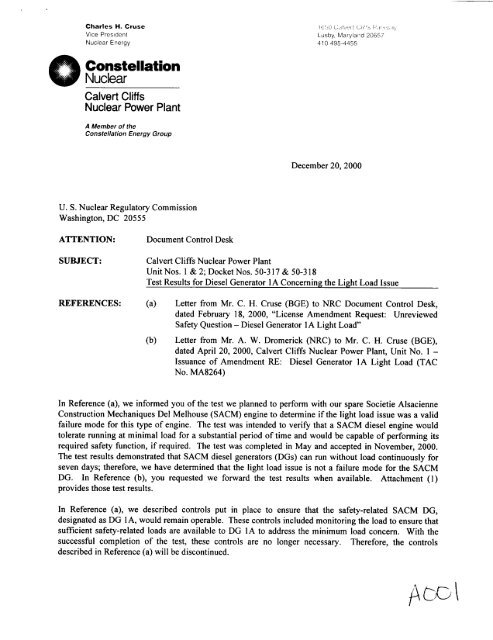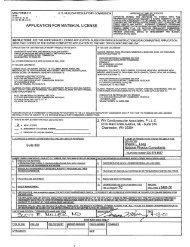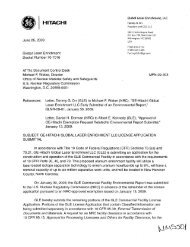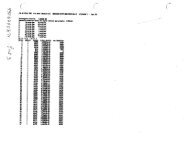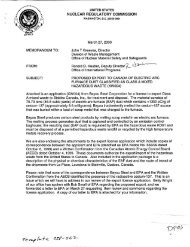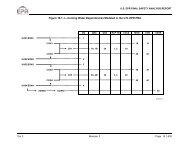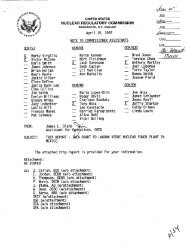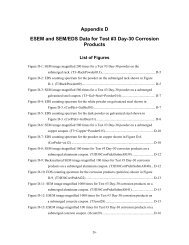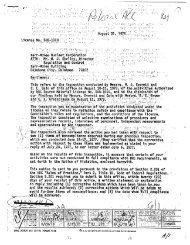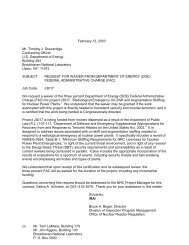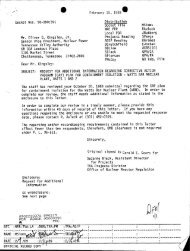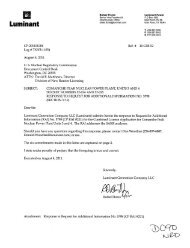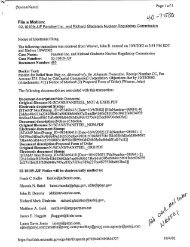Calvert Cliffs Nuclear Power Plant, Unit Nos. 1 & 2 - Test ... - NRC
Calvert Cliffs Nuclear Power Plant, Unit Nos. 1 & 2 - Test ... - NRC
Calvert Cliffs Nuclear Power Plant, Unit Nos. 1 & 2 - Test ... - NRC
You also want an ePaper? Increase the reach of your titles
YUMPU automatically turns print PDFs into web optimized ePapers that Google loves.
Charles H. Cruse I' it<br />
Vice President Lusby, Maryland 20657<br />
<strong>Nuclear</strong> Energy 410 495-4455<br />
I Constellation<br />
<strong>Nuclear</strong><br />
<strong>Calvert</strong> <strong>Cliffs</strong><br />
<strong>Nuclear</strong> <strong>Power</strong> <strong>Plant</strong><br />
A Member of the<br />
Constellation Energy Group<br />
December 20, 2000<br />
U. S. <strong>Nuclear</strong> Regulatory Commission<br />
Washington, DC 20555<br />
ATTENTION:<br />
SUBJECT:<br />
Document Control Desk<br />
<strong>Calvert</strong> <strong>Cliffs</strong> <strong>Nuclear</strong> <strong>Power</strong> <strong>Plant</strong><br />
<strong>Unit</strong> <strong>Nos</strong>. 1 & 2; Docket <strong>Nos</strong>. 50-317 & 50-318<br />
<strong>Test</strong> Results for Diesel Generator lA Concerning the Light Load Issue<br />
REFERENCES: (a) Letter from Mr. C. H. Cruse (BGE) to <strong>NRC</strong> Document Control Desk,<br />
dated February 18, 2000, "License Amendment Request: Unreviewed<br />
Safety Question - Diesel Generator IA Light Load"<br />
(b) Letter from Mr. A. W. Dromerick (<strong>NRC</strong>) to Mr. C. H. Cruse (BGE),<br />
dated April 20, 2000, <strong>Calvert</strong> <strong>Cliffs</strong> <strong>Nuclear</strong> <strong>Power</strong> <strong>Plant</strong>, <strong>Unit</strong> No. I<br />
Issuance of Amendment RE: Diesel Generator IA Light Load (TAC<br />
No. MA8264)<br />
In Reference (a), we informed you of the test we planned to perform with our spare Societie Alsacienne<br />
Construction Mechaniques Del Melhouse (SACM) engine to determine if the light load issue was a valid<br />
failure mode for this type of engine. The test was intended to verify that a SACM diesel engine would<br />
tolerate running at minimal load for a substantial period of time and would be capable of performing its<br />
required safety function, if required. The test was completed in May and accepted in November, 2000.<br />
The test results demonstrated that SACM diesel generators (DGs) can run without load continuously for<br />
seven days; therefore, we have determined that the light load issue is not a failure mode for the SACM<br />
DG. In Reference (b), you requested we forward the test results when available. Attachment (1)<br />
provides those test results.<br />
In Reference (a), we described controls put in place to ensure that the safety-related SACM DG,<br />
designated as DG 1A, would remain operable. These controls included monitoring the load to ensure that<br />
sufficient safety-related loads are available to DG IA to address the minimum load concern. With the<br />
successful completion of the test, these controls are no longer necessary. Therefore, the controls<br />
described in Reference (a) will be discontinued.<br />
jc7A-
Document Control Desk<br />
December 20, 2000<br />
Page 2<br />
Should you have further questions regarding this matter, we will be pleased to discuss them with you.<br />
Very truly yours,<br />
CHC/DJM/dlm<br />
Attachment: (1)<br />
cc:<br />
Summary of SACM <strong>Test</strong> Results (without Appendices)<br />
R. S. Fleishman, Esquire<br />
J. E. Silberg, Esquire<br />
Director, Project Directorate I- 1, <strong>NRC</strong><br />
A. W. Dromerick, <strong>NRC</strong><br />
H. J. Miller, <strong>NRC</strong><br />
Resident Inspector, <strong>NRC</strong><br />
R. I. McLean, DNR
ATTACHMENT (1)<br />
SUMMARY OF SACM TEST RESULTS<br />
<strong>Calvert</strong> <strong>Cliffs</strong> <strong>Nuclear</strong> <strong>Power</strong> <strong>Plant</strong><br />
December 20, 2000
Type of document<br />
41rw) No DLRE 3916<br />
wArsTILA NSD DLRE NOTE Index: B<br />
WArtsilbi France Regarding CC<br />
Technology UD45 V16 S5D 1200 RPM Date: 19/09/00<br />
_ Page: 1/9<br />
CD<br />
CD<br />
Subject<br />
Endurance brake test at very low load on 4683 engine<br />
Special note<br />
This test was carried out according to test program WF/T-UD 0009 A<br />
Summary<br />
See page 2<br />
Distribution<br />
With appendices<br />
Mathieu KAUNY<br />
Without appendix<br />
Patrice FLOT<br />
Ginette KITTLER<br />
Henri BIRNER<br />
Femand CLAUSS<br />
Jean Paul VERDUN<br />
Chris MULLER<br />
Michel SCHMITT<br />
Before implementing this document, the user tust check its validity<br />
INDEX DATE SUBJECT OF THE WRITER CONTROL APPROVAL<br />
MODIFICATION<br />
A 11 07 00 First issue P. LAURENT H, BIRNER M. KAUNY<br />
B 19 09 00 Modificaton following first P. LAURENT H. BIRNER M. KAUNY<br />
reading I I I _I<br />
APPROVAL OF APPLICABLE INDEX<br />
Writer Control Approval<br />
Name P. LAURENT H. BIRNER M. KAUNY<br />
Visa
Type of document<br />
d(W- No DLRE 3916<br />
wArTSLA NSD DLRE NOTE Index: B<br />
W trtsiIl France Regarding CC<br />
Technology UD45 V16 S5D 1200 RPM Date: 19/09/00<br />
Page: 2/9<br />
Summary<br />
SUM M A R Y .............................................................................................................................................................. 3<br />
1.I INTRODUCTION ............................................................................................................................................. 4<br />
2. DEVELOPMENT OF TEST ............................................................................................................................ 4<br />
2 .1. IN C ID EN T S .............................................................................................................................................. 4<br />
2.2. EVOLUTION OF MAIN ENGINE PARAMETERS ..................................................................... ................ 4<br />
2.3. ANALYSIS OF LUBRICATING OIL AND FUEL ........................................................................................... 6<br />
2.3.1 E ng ine lubricating oil. ................................................................................................................................. 6<br />
2.3.2. Turbocharger lubricating oil ...................................................................................................................... 6<br />
2 3.3 . F uel .................................................... ..................................................................................................... 6<br />
2 .4. V IB R A TIO N S ................................................................................. ..................................................... 6<br />
2.5. IN C RE ASE IN PO W ER ................................................................................................................................ 6<br />
3. COMPARATIVE MEASUREMENTS BEFORE AND AFTER TEST ...................................................... 7<br />
4. COMPARATIVE VISUAL EXAMINATION BEFORE AND AFTER TEST ........................................... 7<br />
4.1. EXAMINATION BEFORE TEST ........ ........................................................... 7<br />
4.2. A FTER TEST .............................................................. . .................................................. . ........... 7<br />
5. C O N C LU SIO N ....................................................................................................................... .................... 8<br />
6. RECONDITIONING ................................................................................................................ ................ 8<br />
Appendices<br />
1. Incident report<br />
2. Values of engine parameters<br />
3. Analysis of engine oil<br />
4. Analysis of turbo oil<br />
5. Analysis of fuel<br />
6. Analysis of liquid in intake manifolds<br />
7. Measurements of vibrations<br />
8. Measurements before test<br />
9. Measurements after test<br />
10. Piston shaft examination reports<br />
11. Photos before test<br />
12. Photos after test<br />
13. Photos of an EDF big end bearing<br />
14. Video of smoke coming from chimney<br />
15. <strong>Test</strong> procedure
Type of docunent N DLRE 3916<br />
WARTSILA NSD DLRE NOTE Index: B<br />
W~irtsil France Regarding CC<br />
Technology UD45 V16 S5D 1200 RPM Date 19109/00<br />
Technology_<br />
Page: 3/9<br />
SUMMARY<br />
The aim of this test was to check:<br />
"* That the engine could work for 168 hours with very low load which represents 3.1 % of the<br />
nominal power<br />
"* That at the end of the test it was still possible to increase the power in a relatively short time.<br />
The engine was stopped once by an electrical power cut of the grid. In the minutes following this<br />
cut, it started up again without problems.<br />
The fuel racks of the injection pumps tended to jam. It is probably due to long term storage of the<br />
engine before the test.<br />
None of the cylinders failed. This was the major worry before the test. The temperatures of the<br />
cylinders remained on the whole very stable throughout the test.<br />
At the end of the very low load test power was increased as planned, without any particular<br />
problem. During the change from very low load of around 85 kW to around 1530 kW a wreath of<br />
light grey smoke was observed for around 2 minutes. During the change from 1530 kW to 2785 kW<br />
a wreath of not too thick black smoke was observed for about 1 minute. At nominal power the<br />
values of engine parameters are within the criteria of the new engine.<br />
Slight wear was measured on some components.<br />
The general condition of the 4 cylinders dismantled after the test is very similar to that before the<br />
test. There was no important deposit in the manifolds, the cylinder heads, or the turbochargers.<br />
The increase in load over 3 hours after the very low load test cleaned all the soot that had<br />
accumulated. Usual cavitation marks can be seen on rod bearings. This is slight caviation not<br />
critical. We can see a quite thick deposit of carbon in a very localised area in the first groove of a<br />
piston. This type of deposit could be dangerous if it were thicker. The bottom of the intake<br />
manifolds is full of a greasy liquid which resembles engine lubricating oil, and almost certainly<br />
comes from the crankcase ventilation. These manifolds should be cleaned after lengthy running at<br />
very low load.<br />
This test has showed that the UD45V16S5D 1200 RPM can continuously run at very low load<br />
down to 85 kWm, for up to 7 days, for emergency purpose and that it is always possible to<br />
increase the load up to the nominal load in a relative short time.
1. INTRODUCTION<br />
The aim of this test was to check:<br />
"* That the engine could work for 168 hours with very low load of approximately 85 kWm at 1200<br />
RPM, which represents 3.1 % of the nominal power of 2785 kWm at 1200 RPM or a BMEP of<br />
0.5 bar.<br />
" That at the end of the test it was still possible to increase the power in a relatively short time.<br />
(The m in kWm indicates that the power is mechanical just after flywheel to avoid confusion with<br />
the power just after generator which is electrical and generally written kWe. kWe = kWm *<br />
generator efficiency.)<br />
2. DEVELOPMENT OF TEST<br />
2.1. Incidents<br />
Only one incident occurred.<br />
The engine was stopped by an electrical power cut of the grid after 41 hours of running at very low<br />
load. The engine restarted normally, but a fuel rack was stuck. This fuel rack was quickly freed by<br />
hand, without stopping the engine. It was then decided to lubricate all the fuel racks regularly,<br />
every 8 hours.<br />
The cause of this jamming is probably:<br />
"* Long term storage of the engine<br />
For an engine in-service the recommendation is to lubricate the racks every 6 months. In that case<br />
it should be effective at preventing sticking.<br />
2.2. Evolution of main engine parameters<br />
Nothing abnormal.<br />
Nothing abnormal.<br />
Remarks
Type of document<br />
C• N° DLRE 3916<br />
wAr TsiLA NSD DLRE NOTE Index: B<br />
W~irtsilt France Regarding CC<br />
Technology UD45 V16 S5D 1200 RPM Date: 19/09/00<br />
Technology_ _ _ Page: 5/9<br />
Variable 10 Nothing abnormal.<br />
load 4 th<br />
period<br />
Variable 10 Nothing abnormal.<br />
load 5 t"<br />
period<br />
Very low 168 LT temperature before air cooler:<br />
load<br />
Increase 3 Nothing abnormal.<br />
in load<br />
This varies between 52 and 56 ° C. It remains within the normal range for<br />
this type of engine.<br />
Exhaust temperatures side A:<br />
3 stages can be noted: a period at the start of test, from 16 05 to 18 05,<br />
when temperatures vary considerably; a period from 18 05 to 21 05, when<br />
temperatures are very stable; and a period from 21 05 to 23 05 when<br />
temperatures vary. The minimum temperature is 160 0 C at a very specific<br />
time. This is as a consequence of the stopping of the engine in this period.<br />
The engine took a little while to return to its normal temperature. The<br />
average temperature is very stable at around 210 0 C with a slight tendency<br />
to increase. The maximum temperature is 265 0 C. None of the cylinders<br />
failed.<br />
Exhaust temperatures side B:<br />
They are very stable, with a slight tendency to increase. The minimum<br />
temperature is 160 °C for the B5 cylinder. The temperature of this cylinder<br />
remains between 160 and 170 0 C. This cylinder is the coldest in the engine.<br />
None of the cylinders failed. The average temperature is approximately 210<br />
°C, as for side A. The maximum temperature is 260 0 C. The engine shut off<br />
on the 18 05 00 is much less noticeable on the cylinders than on side A. It<br />
can be noticed only in the average.<br />
Turbo speed :<br />
This tends to increase in both turbos. This must result from clogging up of<br />
the nozzle rings. The cross section of the nozzle rings is reduced and causes<br />
the outflow speed and turbo speed to increase.<br />
Air pressure after compressor:<br />
This tends to increase. It is as a result of the increase in turbo speed.<br />
Exhaust gas pressure before turbine.:<br />
Sharp variations are noted. The sensors were not working very well from the<br />
beginning to % of the test due to the connection of the sensor to the small<br />
pipe coming from the engine and the cleanliness of the small pipe itself.<br />
Fuel consumption:<br />
The specific fuel oil consumption is very high, which is normal at very low<br />
load. It tends to increase. It is almost certainly as a result of clogging up.
Type of document<br />
N" DLRE 3916<br />
WARTSILA NSD DLRE NOTE Index: B<br />
Wtirtsild France Regarding CC<br />
Technology UD45 V16 S5D 1200 RPM Date: 19/09/00<br />
Technology_ _ _ Page: 6/9<br />
2.3. Analysis of lubricating oil and fuel<br />
2.3.1 Engine lubricating oil<br />
Increases in the content of the following metals are noted:<br />
* Copper which goes from 0 to 32 ppm<br />
* Lead which goes from 0 to 6 ppm<br />
* Tin which goes from 0 to 5 ppm<br />
The copper almost certainly comes from the passivation of the water-lubricating oil exchanger.<br />
The Lead and tin almost certainly come from erosion of bearings, especially those of the big ends,<br />
as can be seen in the photos.<br />
None of the parameters is critical with regard to our criteria.<br />
Parameters Criteria Criteria Lowest Highest <strong>Unit</strong>s<br />
Min. Max. measured measured<br />
Viscosity at 100° 11.6(-20%) 15.95(+10%) 13.8 15.6 cSt<br />
C<br />
Flash point 150 >180 °_C<br />
Water Content 0.5 0.08 %<br />
BN 6.58 (-30 %) 9.4 mgKOH/g<br />
Pb Content 55 ppm/1 00 h 2.6 ppm/100 h<br />
Sn Content 10 ppm/1 00 h 2.1 ppm/100 h<br />
2.3.2, Turbocharaer lubricatina oil<br />
The analysis after test show a little mixture of turbine oil and engine oil. It seems the previous oil,<br />
which was an engine lubricating oil, was not completely drain. Generally it is difficult to drain all the<br />
previous oil. There is no particular wear. It is necessary to change the oil for the next running.<br />
2.3.3. Fuel<br />
The analysis show the fuel is in accordance with our recommendation ( DL Do 6290 ) with a sulfur<br />
content very low 0.0309 and 0.0374 %.<br />
2.4. Vibrations<br />
On the whole, variations are relatively small. It is difficult to make out any tendency.<br />
2.5. Increase in power<br />
There were no particular problems when power was increased.<br />
Observation of smoke coming from chimney:<br />
Change from 85 kW to 1530 kW, wreath of light grey smoke for approximately 2 minutes.
Type of document<br />
No DLRE 3916<br />
WARTSILA NSD DLRE NOTE Index: B<br />
Wtrtsil~l France Regarding CC<br />
Technology UD45 V16 S5D 1200 RPM Date: 19/09100<br />
Page: 7/9<br />
Change from 1530 to 2785 kW, small wreath of not too thick black smoke for approximately I<br />
minute.<br />
No hot embers were seen.<br />
3. COMPARATIVE MEASUREMENTS BEFORE AND AFTER TEST<br />
Components<br />
Big end bearings<br />
Master rods<br />
Slave rods<br />
Piston shafts<br />
Slave rod shafts<br />
Piston grooves<br />
Piston rings<br />
Valve guides<br />
Intake valves<br />
Exhaust valves<br />
Valves penetration<br />
Liners<br />
Liner boroscope<br />
Calibration of injector holders<br />
Observations<br />
Average wear of 0.006 mm.<br />
Small variations within criteria.<br />
Small variations within criteria.<br />
No wear.<br />
No wear.<br />
No wear.<br />
Slight increase in thickness after tests. This may be the<br />
result of slight deposit on the sides or repeatability of the<br />
measurement. Slight wear can be seen on the friction<br />
surface which was measured at the split. Average<br />
increase of the split gap 0.032 mm.<br />
Hardly no wear.<br />
Slight wear on stems. Average wear 0.017 mm.<br />
Hardly no wear on stems.<br />
Slight penetration can be seen, due to slight wear of seats<br />
and valves. Average penetration 0.064 mm.<br />
No wear.<br />
On the whole, no change.<br />
Slight decalibration, which remains within the criteria.<br />
4. COMPARATIVE VISUAL EXAMINAT1ON BEFORE AND AFTER TEST<br />
4.1. Examination before test<br />
The components are as new. Some small marks or traces of functioning can been seen.<br />
4.2. After test<br />
Components<br />
Big end bearings<br />
Observations<br />
We can see usual cavitation marks. We can see this shape of cavitation<br />
marks on all the UD45 engines more or less deep. This is a slight cavitation<br />
that affect only the tin/lead overlay. According to our experience it is no<br />
critical and the engine can still running.<br />
For comparison in appendix there are photos of an EDF (French electricity<br />
supplier) rod bearing after 5 years running in an emergency gen-set. This is<br />
heavy cavitation that has proceeded in copper/lead lining layer. This<br />
bearing have to be replaced.<br />
The cavitation marks with the shape observed is classical on UD45
Type of document<br />
N" DLRE 3916<br />
wATzTsiLA NSD DLRE NOTE Index: B<br />
Wartsild France Regarding CC<br />
Technology UD45 V16 S5D 1200 RPM Date: 19/09100<br />
1___ 1 Page: 8/9<br />
.4.. -A<br />
Slave rods<br />
Pistons<br />
Piston shafts<br />
Intake valves<br />
Intake manifolds<br />
engines. It seems to be due to sudden variation of the position of the crank<br />
pin in the gap formed by the bearing. The sudden movements, the groove<br />
and hole in an area in depression make the oil boiling. The boiling<br />
generates bubbles which collapse when the pressure increase and damage<br />
the bearing surface.<br />
An important scratch on one edge of the small end bushing rod 64. This<br />
scratch was almost certainly made by a foreign particle. A small mark can<br />
also be seen on the shaft of the corresponding piston.<br />
A small area of quite thick carbon deposit, of around lmm, in the first<br />
groove of piston A4. This type of deposit could be dangerous if it were<br />
thicker. On piston A5 black colouring can be seen in the first groove over<br />
half of the piston.<br />
Some bluish areas on the opposite of the bushing. This colouring is not<br />
usual. This colouring is due to the formation of iron oxides on the surface.<br />
During the low load running the combustion forces are low, the main forces<br />
are inertia forces. So the piston shaft movement is low and in consequence<br />
the oil flow between the shat and bushing is low. There can be local<br />
contacts that create heat then iron oxides.<br />
The temperature remains low and there is no modification of the material<br />
structure. These bluish areas have no consequences on the shaft strength.<br />
These shafts can be reused.<br />
Slight carbon deposit on the heads.<br />
The bottom of the manifolds is full of a greasy liquid resembling engine<br />
lubricating oil.<br />
5. CONCLUSION<br />
This test has showed that the UD45V16S5D 1200 RPM can continuously run at very low load<br />
down to 85 kWm, for up to 7 days, for emergency purpose and that it is always possible to<br />
increase the load up to the nominal load in a relative short time. Even it is recommended to<br />
increase the load at the end of a low load running period to bum out all the accumulated soot.<br />
6. RECONDITIONING<br />
Minimum advised<br />
Replacement of all the big end bearings<br />
Cleaning of the intake manifolds<br />
Changing of oil in the turbochargers<br />
The safest<br />
Minimum advised and<br />
Dismounting, cleaning and inspection of all the cylinder heads<br />
Cleaning of all the pistons and piston rings<br />
Magnetic power inspecting of all the piston shafts<br />
Dismounting of all the cylinder heads in order to change all the gaskets
Type of document N DLRE 3916<br />
wArTSILA NSD DLRE NOTE Index : B<br />
WrtitFrce Regarding CC"<br />
Wrts France Rega UD45 V16 S5D 1200 RPM DateC:1909100<br />
Technology Date: 9/9<br />
I I Page: 919<br />
After reassembling a small brake test is necessary to check well running. We suggest:<br />
* One hour at 25 % of nominal load<br />
* One hour at 50 % of nominal load<br />
a One hour at 75 % of nominal load<br />
* One hour at 100 % of nominal load


